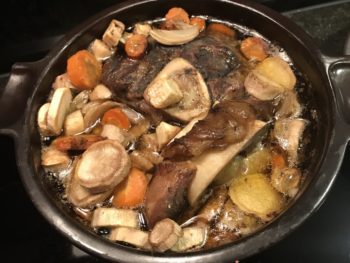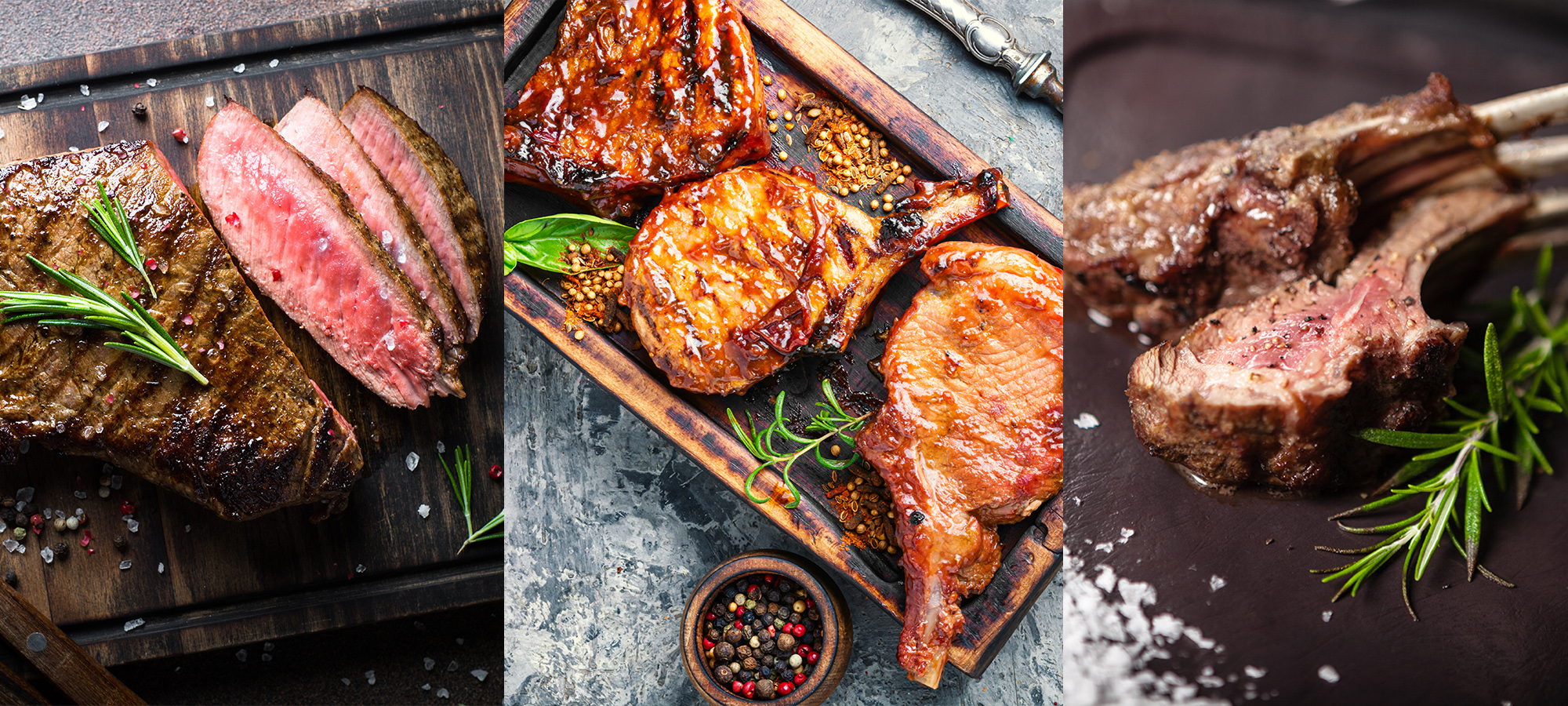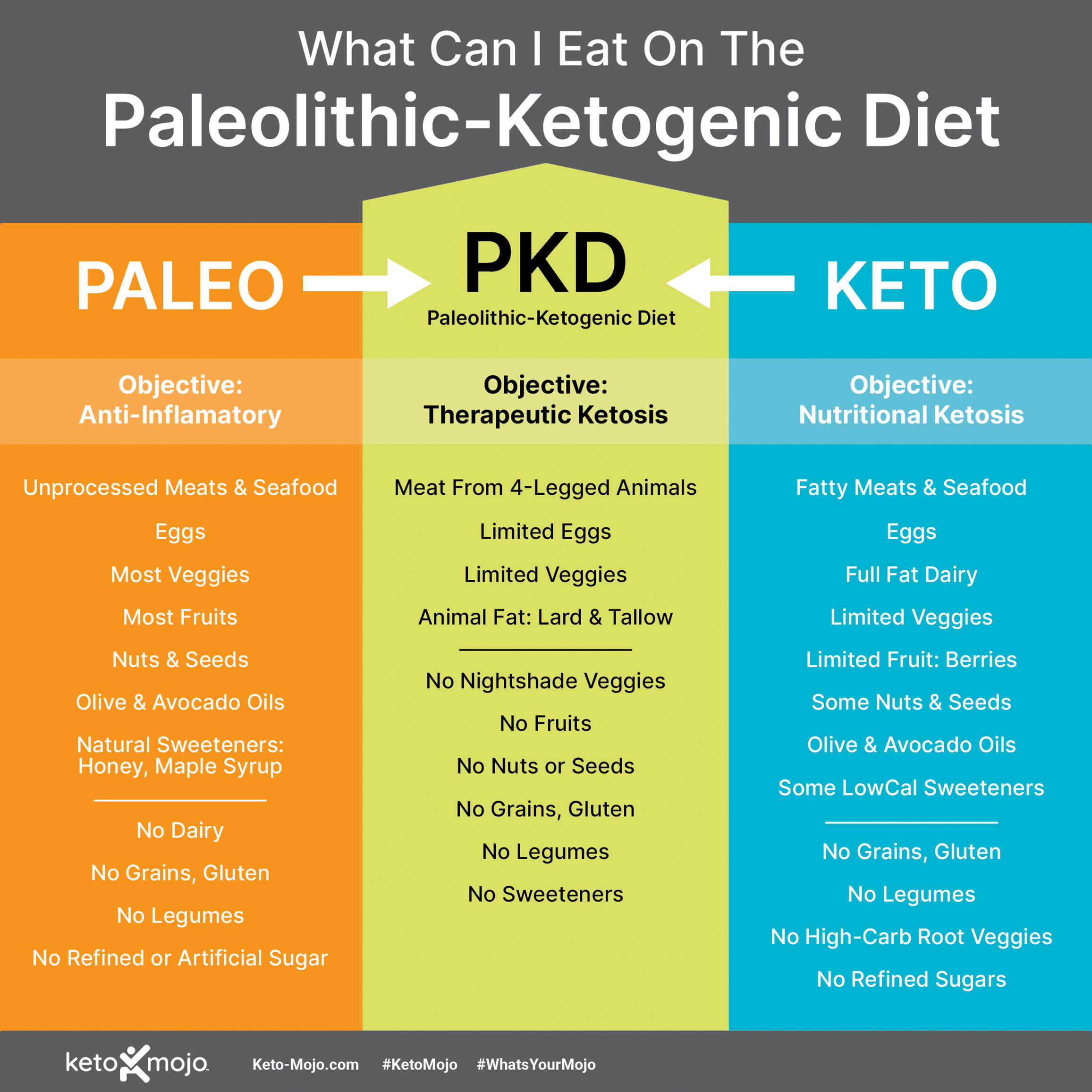The ketogenic diet is a very low-carbohydrate, moderate protein, and high-fat diet. It puts the body into the state of ketosis which means that instead of glucose the body burns fat for energy. The quality of the food is usually not defined on the classical ketogenic diet. It might be whole-food based, but it might also contain a lot of processed food, unhealthy oils and fats and it’s typically loaded with artificial sweeteners.
The benefits of the ketogenic diet come from the state of ketosis. These benefits are well documented in the case of different diseases such as epilepsy and other neurological conditions, high blood pressure, diabetes, and obesity, just to mention a few.
The Paleolithic (Paleo) Diet includes only food items that were believed to be available in the paleolithic times before the advent of agriculture. These are fruits, certain vegetables, tubers, fish and seafood, grass-fed lean meat, pasture-raised poultry and eggs, nuts, seeds, and their oils. It excludes all grains and cereals, dairy, nightshades, legumes, sugar, and processed foods. The paleo diet is usually low in fat, moderate in protein, and high in plant foods.
The Paleolithic Diet was pioneered by Professor Loren Cordain from Colorado State University. He suggested that it was the single optimal diet for all Homo Sapiens.
The Paleolithic-Ketogenic Diet (PKD) combines these two diets to get the benefits of both while at the same time, excluding their negatives.
The Benefits of PKD
PKD has all the advantages that come from the state of ketosis, but it goes further by excluding inflammatory foods and in this way, it helps to heal an elevated intestinal permeability. A healthy intestinal barrier is selectively permeable, permitting the absorption of essential nutrients and water while maintaining protection against microorganisms and toxins. A disrupted intestinal barrier function is known to lead to inflammation and disease.
When gut integrity is restored on PKD, the improvement of many chronic conditions, such as different autoimmune diseases and cancer, will follow.
The Paleolithic Ketogenic Diet is an evolutionary adapted diet. It was developed in Hungary by Dr. Zsófia Clemens Ph.D. and Dr. Csaba Tóth, in 2010-2013. The diet is derived from clinical evidence and is based on data from more than 10,000 patients over the past 10 years.
The Paleolithic Ketogenic Diet has been used by the International Center for Medical Nutritional Intervention (ICMNI), formerly known as Paleomedicina, Hungary, to treat many chronic diseases, such as different types of autoimmune diseases and cancers since 2012.
The benefits of PKD come from different aspects:
- Its ability to induce ketosis – the natural physiological state of the human body.
- Provides all essential nutrients without any supplements.
- Heals leaky gut syndrome by excluding all possible natural toxins and additives in food.
While following the classical ketogenic diet has enormous benefits due to ketosis, it can still inhibit healing because of consuming certain inflammatory foods that lead to elevated intestinal permeability and chronic inflammation. These foods include excessive dairy, plant oils (like corn, canola, and soy), nuts, seeds, and nightshades.
What Can I Eat on a PKD Diet?
There are two versions of PKD, depending on the health status and the goal of the person.
For people with a serious illness, only meat, animal fat, and organ meats from four-legged animals, preferably grass-fed, pasture-raised, and organic, are recommended. The quantity of food and a 2:1 fat to protein ratio is also specified.
For recovered and/or healthy people, there are some food allowances. This means that fish, chicken, or other birds and eggs can be added to the diet, as well as certain vegetables, fruits, and honey. No nuts and seeds. Plants shouldn’t exceed 30% of the daily food intake.
On the one hand, to heal a disease, it is very important to avoid all inflammatory foods. On the other hand, foods that ensure adequate macro- and micronutrient intake are required. When following PKD, the proper ratio of food items ensures the intake of all the necessary essential fatty acids, amino acids, vitamins, minerals, and trace elements.
The basic rule is to eat when hungry and drink when thirsty. We usually eat once or twice a day because the state of ketosis suppresses our hungry in between while enjoying high levels of energy throughout the day.
Patients are asked to monitor their blood glucose and ketone levels daily. The goal is to achieve stable ketosis, in PKD it means to have a blood glucose level at or under 80 mg/dL (4.5 mmol/L) and ketones between 2-3.5 mmol/L.
This diet is suitable for children, adults, and seniors and there are no side effects when followed properly. There is no need to take any dietary supplements.
PKD is not recommended only in the case of a few rare conditions because of which a patient is unable to metabolize fat and/or protein.
Is PKD Safe?
As long as we stick to our evolutionary-adapted diet (PKD), we don’t need to supplement our diet with anything. All necessary nutrients are included in the food we eat. Most nutritional supplements also have side effects due to their active ingredients and the additives they contain.
People on PKD have normal vitamin and mineral levels.
Let’s look at a few important nutrients on PKD:
Vitamin C
The amount of vitamin C we need highly depends on our diet. A high carbohydrate diet and elevated blood glucose hinder the absorption of vitamin C. In addition, on a meat-fat-based diet, much less reactive oxygen species are produced than on a high-carb diet, so much fewer antioxidants are needed.
The best sources of vitamin C on PKD are internal organs like brain and liver.
Vitamin D
The levels of vitamin D are influenced by many things, such as medications, surgery, trauma, and metabolic health. When eating organ meats and animal fat on a regular basis, the levels of vitamin D are normal on PKD.
Vitamin D supplementation for a short period of time may be recommended on PKD in advanced cases to build up blood levels quickly.
Magnesium
Mg deficiency is a common problem nowadays. However, patients following PKD and taking no medication or supplements have normal Mg levels.
The estimated daily intake of Mg on PKD is much lower than the recommended daily intake. It is still enough because, on the one hand, a very low carbohydrate diet requires much less Mg than a high carbohydrate diet. On the other hand, by avoiding fibers, phytates, and oxalates that hinder Mg absorption, more of it will be available and absorbed.
Shopping Tips on PKD
The quality of the food we eat is extremely important. Whenever possible, we should consume organic, local, free-range meat and eggs, wild-caught fish, and organic, local, and seasonal vegetables and fruits.
Studies have shown negative effects of processed meat but this is due to the nitrites, sugar, and other additives. Traditionally smoked and salted products are perfectly fine and can be consumed without any concerns. The only challenge is that these products are very difficult to find.
I recommend that you search online and visit farmers’ markets for the best quality local products.
If you buy any processed meat (sausages, bacon) at your butcher, please always ask for the list of all ingredients. Buy only products that are free of any harmful chemicals. Always remember to read food labels and buy only the best quality food to optimize your health.
PKD Case Studies
ICMNI has treated over 10,000 patients in over 10 years with PKD. Here are just a few examples of documented case studies where PDK was used to treat different disease states.
- Complete cessation of recurrent cervical intraepithelial neoplasia (CIN) – a case where recurrent cervical intraepithelial neoplasia (CIN), a premalignant condition of cervical cancer, was successfully treated with the Paleolithic Ketogenic Diet. The patient had a history of high-grade CIN in 2011, which was successfully treated with cervical conization and fractional In October 2015 she was found to have a recurrence of high-grade CIN (HSIL: High-Grade Squamous Intraepithelial Lesion).
The patient then began a paleolithic ketogenic diet and her repeat Pap (Papanicolaou) smear three months later was found to have reverted to normal. The patient has remained on PKD for 26 months, her repeat smears have stayed normal, and she is free of symptoms and side effects.
- Crohn’s disease successfully treated – a 14-year-old boy was diagnosed with severe Crohn’s disease. The paleolithic ketogenic dietary therapy resulted in the resolution of symptoms, normalized laboratory parameters as well as a gradual normalization of bowel inflammation as evidenced by imaging data, and a normalization of intestinal permeability as shown by the polyethylene glycol (PEG 400) challenge test.
The patient was able to discontinue medication within two weeks. At the time of the case documentation, he had been on the diet for 15 months and is free of symptoms as well as side effects.
- Gilbert’s Syndrome (GS) Successfully Treated with the Paleolithic Ketogenic Diet – GS was accidentally discovered in the female patient aged 30 due to a routine laboratory test. It is a chronic, life-long condition of altered bilirubin metabolism. Patients with Gilbert’s syndrome have higher than normal bilirubin levels in their blood causing jaundice and possibly other symptoms. This patient had a 10-year history of regular migraines, as well as fatigue, constipation, and dermatitis. She had no medication or dietary supplements. Her BMI was 17.9.
She started a PKD diet plan that included meat, fat, organs, eggs, and a small amount of vegetables and fruits. She avoided all food additives and sweeteners, except for a small amount of honey. Her condition normalized and all her symptoms resolved on the diet.
Note: patients with disease or on medication should not do PKD alone. Please contact a qualified healthcare provider.
Bonus PKD Recipe: Oven Meat Stew

(4-5 servings)
Ingredients:
- 1 kg (2.2 lb) fatty beef, veal, lamb, or pork, or the combination of them, cut into large chunks; use fatty meat, such as brisket. There should be a bit less than 1/3 visible fat on the meat.
- 2 tbsp lard, tallow, or duck fat
- 100 g (3 ½ oz) nitrite-free bacon, cut into small cubes or slices
- 2 small carrots
- 2 small parsley roots
- a small slice of celery root
- 1 onion (optional)
- 1 tsp salt
- 1/4 tsp coarsely ground black pepper
- 1 cup bone broth or water (prefer broth if you have it)
- 1 bay leaf (optional)
Instructions:
- Heat oven to 150 °C (300 °F).
- Pre-fry the bacon, chunks of meat and the vegetables in the fat first, then put into a large oven-proof pot
- Add broth or water, mix ingredients, cover, and place the oven-proof pot in the oven to roast for 3-4 hours.
About the Author
After training as a language teacher, Orsolya Szathmári became interested in natural care, a balanced diet, and healthy living as a means to treat different health conditions and practice disease prevention.
Her studies included holistic healthcare, alternative medicine, and nutritional therapies. She became a certified naturopath and nutritional therapist in 2015, and later a certified as a GAPS practitioner and sports nutrition.
More recently, Orsolya discovered the Paleolithic Ketogenic Diet (PKD) which she follows personally and also coaches others to follow.
For more information, refer to the ICMNI (The International Center for Medical Nutritional Intervention) or her website.




